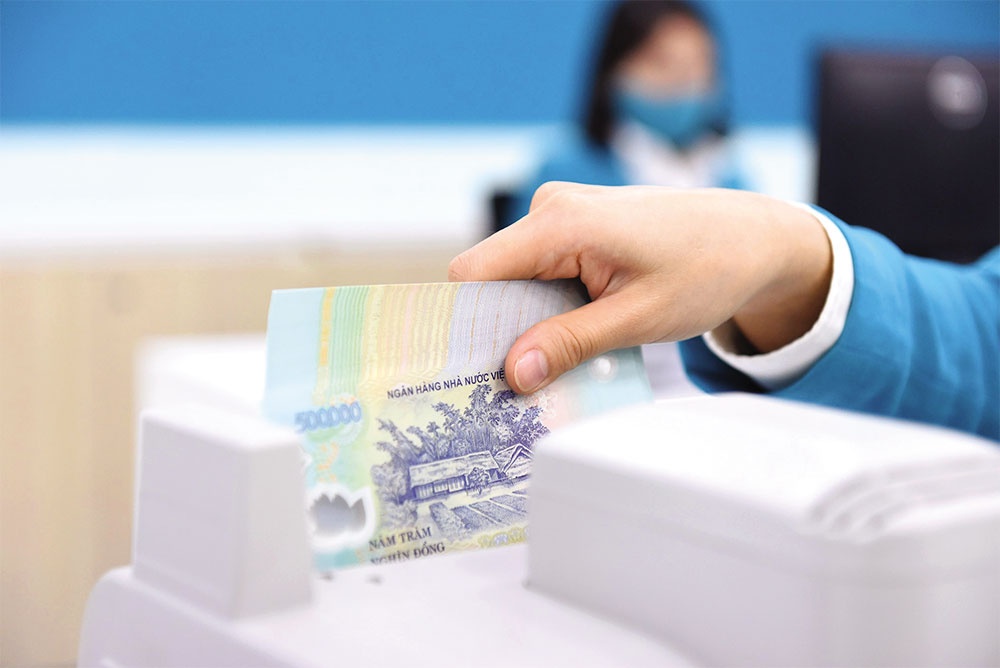Credit growth high amid hikes in LDR
According to the State Bank of Vietnam (SBV), credit growth reached 11.5 per cent by the end of October 2022. By the end of September, the deposit growth rate was only 4.6 per cent, much lower than that of credit growth. This began to occur in mid-2021 when residential capital flowed into the stock market and corporate bonds, as they had more attractive returns than savings.
Accordingly, commercial bank deposits from the population increased very slowly, with negative growth at times.
“When credit regains its growth momentum as businesses restart production and expansion activities, the capital mobilised from the population immediately falls, causing liquidity stress. This partly explains the sharp increase in deposit interest rates in recent times,” said Tran Thi Khanh Hien, director of Analysis at VNDIRECT Securities.
 |
| Deposit interest rates at many banks are higher than before the pandemic emerged, photo Le Toan |
A World Bank expert said credit growth cooled in October but remained high overall. After reaching a record of 16.9 per cent on year growth in September, credit growth slowed to 16.5 per cent in October. The rates were due to the impact of the SBV’s tightening measures for domestic financial mobilisation by raising interest rates a total of 200 basis points in September and October.
“Overnight interbank interest rates hit a record at an average of 5.8 per cent in October compared to 4.9 per cent in September 2022, much higher than the 0.65 per cent interest rate in the previous year. Interest rates were also more volatile, ranging from a 3.1 per cent bottom to a peak of 8.4 per cent in October,” the World Bank expert said.
According to a government circular, banks are required to meet the maximum LDR at 85 per cent in tier-1 markets (transactions between financial institutions and businesses/people) and tier-2 (interbank transactions between financial institutions and between the SBV and those institutions). Some banks with a competitive advantage in the interbank market, especially with capital sources from foreign banks, will have an LDR ratio lower than the conventional LDR, which accounts for the first tier only.
According to the economist, bank LDR ratios are usually high, mostly exceeding 85 per cent, especially at Techcombank and VPBank. Despite the traditionally high LDR ratios, these two banks typically receive large offshore loans, which can be included in the LDR. In addition, market movements showed that Techcombank and VPBank have made clear moves to increase deposit interest rates to reduce the LDR ratio.
A report released last week by SSI Research showed that the movements of deposit interest rates at joint-stock commercial banks are still complicated, and long-term liquidity in the system has not improved. In addition to promotion programmes and the addition of interest rates over 6 months to attract cash flow, many large commercial banks, such as Techcombank or VPBank, have continued to increase demand interest rates to the specified ceiling of 1 per cent.
Up to this point, the deposit interest rates at many banks are higher than before the pandemic, with an average increase of 300-400 basis points compared to the end of 2021.
“If we only consider the LDR ratio according to international practice, 13 of the 15 largest listed commercial banks recorded over 100 per cent, higher than the average 95 per cent last year,” said VNDIRECT’s Hien.
Based on VNDirect’s estimate, domestically, most LDR ratios are currently below the prescribed level of 85 per cent. However, commercial banks that have recorded high credit growth in the past 9 months are approaching this threshold at 83 - 84 per cent. Even if the credit room is further widened, it will be difficult for commercial banks to lend more if they do not promote mobilisation to ensure the liquidity ratio.
Economist Le Xuan Nghia told VIR, “It is not difficult to see that in the current context, banks will not focus on strong loan growth but on risk management and lending to prioritised areas.”
Elsewhere, SeABank successfully raised capital from the US International Development Finance Corporation with a loan of $200 million. Previously, VPBank successfully signed a syndicated loan agreement worth $500 million from five major financial institutions: the Asian Development Bank, Sumitomo Mitsui Banking Corporation, Japan International Cooperation Agency, ANZ Bank, and Maybank Securities Pte., Ltd.
The above international loan is the second successful capital mobilisation by VPBank in 2022 after the bank was given a $600 million syndicated loan in April from major European financial institutions in Asia, including Maybank, Cathay United Bank, CTBC Bank, and Central Bank of India.
“VPBank has continuously consolidated its strong financial potential to meet the increasing credit needs of customers for production and business activities as well as investment and development, by proactively diversifying capital sources both domestically and abroad,” a senior VPBank leader said.
Similarly, VIB completed the withdrawal of a loan of $150 million from the International Finance Corporation (IFC). In addition, the bank has just announced a report to collect shareholders’ opinions on adjusting foreign investors’ maximum share ownership to 30 per cent. Its current largest foreign strategic shareholder, Commonwealth Bank of Australia, has been holding about 20 per cent since 2010.
“IFC’s disbursement of a loan with a term of up to five years to VIB shows the trust that partners have for the bank,” said Han Ngoc Vu, general director of VIB. “This new loan will be added to the bank’s capital structure to better meet customer needs and enhance stability in the face of market fluctuations.”
 | Firms urged to keep abreast of alterations by US Fed Foreign investment flows in Vietnam’s stock market have been impacted by the fourth consecutive interest rate hike by the US Federal Reserve to combat inflation. Businesses in Vietnam are also feeling the strain of expensive USD-denominated loans. Vicente Nguyen, chief investment officer of the Asia Frontier Capital Vietnam Fund, discussed the issue with VIR’s Luu Huong. |
 | Recession threat for 2023 as interest rates continue to rise Despite overcoming the pandemic much better than most other countries, Vietnam is not exempt of another sort of virus that is creeping into the country: inflation. While European Union countries recorded an unprecedented 10.9 per cent in September, a number unheard of for the Euro currency so far, the US recorded 9.1 per cent in June, the highest figure in 40 years. |
What the stars mean:
★ Poor ★ ★ Promising ★★★ Good ★★★★ Very good ★★★★★ Exceptional
Related Contents
Latest News
More News
- Tax sector wraps up 2025 and sets priorities for next year (December 25, 2025 | 14:00)
- A tipping point for digital and hybrid wealth management in Vietnam (December 23, 2025 | 13:33)
- $250 million deal targets women-owned SMEs, sustainable agriculture (December 22, 2025 | 17:40)
- Stock market posts resilient 2025 performance (December 19, 2025 | 18:17)
- Citi Vietnam receives 2025 AmCham CSR recognition (December 19, 2025 | 16:35)
- As global green supply chain reshapes, will Vietnam be left behind? (December 19, 2025 | 08:00)
- Banks gear up for massive capital increases (December 18, 2025 | 17:04)
- Securing capital and efficiency for Vietnam’s 2026-2030 growth ambitions (December 17, 2025 | 10:00)
- Energy sector in need of blended finance mechanisms (December 17, 2025 | 09:00)
- Vietnam still has room to mobilise capital for sustainable growth (December 17, 2025 | 08:57)

 Tag:
Tag:




















 Mobile Version
Mobile Version